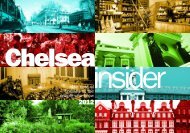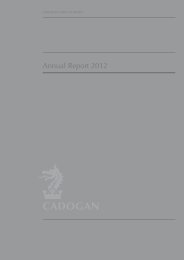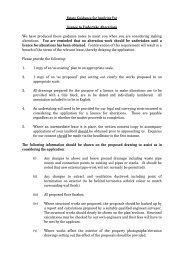The best of Chelsea by the people who know - Cadogan
The best of Chelsea by the people who know - Cadogan
The best of Chelsea by the people who know - Cadogan
You also want an ePaper? Increase the reach of your titles
YUMPU automatically turns print PDFs into web optimized ePapers that Google loves.
9 | HISTORY | Sir Hans Sloane<br />
many <strong>Chelsea</strong> tenants were left facing<br />
ei<strong>the</strong>r hikes in <strong>the</strong>ir rent or eviction.<br />
This trend continued with o<strong>the</strong>r<br />
factors exacerbating <strong>the</strong> situation:<br />
<strong>the</strong> high proportion <strong>of</strong> space-hungry<br />
institutions in <strong>Chelsea</strong> such as <strong>the</strong><br />
Royal Hospital meant less room for<br />
housing, and redevelopment led <strong>by</strong> <strong>the</strong><br />
council started targeting tenants from<br />
higher income groups.<br />
Sections <strong>of</strong> society that had long<br />
called <strong>Chelsea</strong> home, such as <strong>the</strong><br />
artists, were gradually forced out <strong>of</strong> <strong>the</strong><br />
area. <strong>The</strong> cultural revolutions <strong>of</strong> <strong>the</strong><br />
1960s and 1970s sped up this process<br />
through <strong>the</strong> fashionable appeal that<br />
came with <strong>the</strong>m, and <strong>by</strong> <strong>the</strong> mid-1980s<br />
<strong>the</strong> gentrification <strong>of</strong> <strong>Chelsea</strong> was in full<br />
swing.<br />
Today, <strong>Chelsea</strong> still bears <strong>the</strong> marks<br />
<strong>of</strong> its rich cultural heritage: fashion, art,<br />
<strong>the</strong>atre, music and history combine<br />
toge<strong>the</strong>r to create <strong>the</strong> diverse area we<br />
see now.<br />
<strong>Chelsea</strong>’s<br />
founding<br />
families<br />
Two names you see everywhere in<br />
<strong>Chelsea</strong>, from street signs to pubs, are<br />
Sloane and <strong>Cadogan</strong> – <strong>the</strong> families <strong>who</strong><br />
helped make <strong>the</strong> area what it is. And it<br />
all started with a medical genius <strong>who</strong><br />
invented hot chocolate...<br />
Sir Hans Sloane<br />
Sir Hans Sloane is one <strong>of</strong> <strong>the</strong> most<br />
important figures in <strong>Chelsea</strong>’s past and<br />
he is remembered in place names<br />
throughout <strong>the</strong> area, from Sloane Square<br />
to Hans Town to <strong>the</strong> Botanist pub. He<br />
was a physician and philanthropist <strong>who</strong><br />
invented drinking chocolate and gifted <strong>the</strong><br />
nation such a vast collection <strong>of</strong> natural<br />
specimens, books, coins, manuscripts<br />
and artefacts that <strong>the</strong> British Museum<br />
was formed to house <strong>the</strong>m.<br />
<strong>Chelsea</strong> Physic Garden<br />
features a statue <strong>of</strong><br />
Sir Hans Sloane<br />
Royal Borough <strong>of</strong> Kensingon & <strong>Chelsea</strong>, Family & Children’s Service<br />
Born in Ireland in 1660, Sloane studied<br />
botany at <strong>the</strong> <strong>Chelsea</strong> Physic Garden<br />
and chemistry at <strong>the</strong> Apo<strong>the</strong>caries’ Hall.<br />
He travelled around Europe to learn<br />
more about medicine and botany, and<br />
passed his Doctorate <strong>of</strong> Physic in 1683.<br />
He was friends with botanist John Ray<br />
and chemist Robert Boyle (<strong>know</strong>n for<br />
Boyle’s Law).<br />
Sloane quickly became a rising star<br />
in <strong>the</strong> medical field, becoming a Fellow<br />
<strong>of</strong> <strong>the</strong> Royal Society in 1685 at <strong>the</strong> age<br />
<strong>of</strong> 25 and a Fellow <strong>of</strong> <strong>the</strong> Royal College<br />
<strong>of</strong> Physicians in 1687. He set <strong>of</strong>f on a<br />
voyage to Jamaica as <strong>the</strong> 2nd Duke<br />
<strong>of</strong> Albemarle’s physician and wrote<br />
extensive notes about <strong>the</strong> flora and<br />
fauna, local customs and o<strong>the</strong>r points<br />
he found interesting. He also started<br />
collecting samples <strong>of</strong> plants and animals<br />
with a passion.<br />
Sloane invented a recipe for drinking<br />
chocolate, mixing it with milk ra<strong>the</strong>r than<br />
water, after encountering cocoa in<br />
Jamaica. It was originally sold <strong>by</strong> apo<strong>the</strong>caries<br />
as a beverage with health-giving<br />
properties and <strong>by</strong> <strong>the</strong> 19th century, <strong>the</strong><br />
Cadbury Bro<strong>the</strong>rs were selling tins <strong>of</strong><br />
drinking chocolate.<br />
Sloane returned to England in<br />
1689 and set up a medical practice in<br />
Bloomsbury a few years later, which was<br />
hugely successful. He married Elizabeth<br />
Rose, a widow, in 1695, and <strong>the</strong>y had<br />
two daughters – Sarah and Elizabeth.<br />
He was appointed <strong>the</strong> physician to<br />
three different monarchs during his life:<br />
Queen Anne in 1696, George I in 1716<br />
and George II in 1727. He was knighted<br />
in 1716. Sloane became president <strong>of</strong><br />
<strong>the</strong> College <strong>of</strong> Physicians in 1719 and<br />
succeeded Sir Isaac Newton as president<br />
<strong>of</strong> <strong>the</strong> Royal Society in 1727. He<br />
was a socially-minded man and used<br />
some <strong>of</strong> <strong>the</strong> fortune he made providing<br />
medical care to <strong>the</strong> rich to give free<br />
services to <strong>the</strong> poor.<br />
Collecting was an obsession Sloane<br />
pursued throughout his life, and he<br />
bought <strong>the</strong> Manor <strong>of</strong> <strong>Chelsea</strong> from<br />
Charles Cheyne to house and exhibit his<br />
growing collections in 1712. It also gave<br />
him <strong>the</strong> freehold <strong>of</strong> <strong>the</strong> <strong>Chelsea</strong> Physic<br />
Garden, which he supported <strong>by</strong> leasing it<br />
to <strong>the</strong> Society <strong>of</strong> Apo<strong>the</strong>caries in 1722<br />
for £5 a year in perpetuity on <strong>the</strong> condition<br />
that ‘it be forever kept up and<br />
maintained as a physic garden’ and<br />
that 50 plant specimens a year were<br />
delivered to <strong>the</strong> Royal Society until 2,000<br />
pressed and mounted species had been<br />
received. By 1795, <strong>the</strong> total had reached<br />
3,700. <strong>The</strong> peppercorn rent is still paid<br />
to Sloane’s heirs at <strong>the</strong> <strong>Cadogan</strong> Estate<br />
<strong>by</strong> <strong>the</strong> charity that runs <strong>the</strong> <strong>Chelsea</strong>







